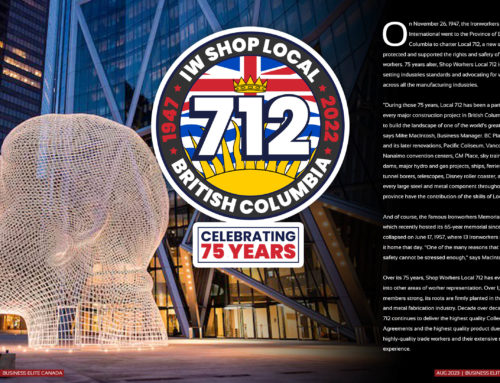A Cornerstone of Canadian Design
By Anna Guy
“Most of the iconic buildings in Ottawa that Canadians are familiar with, as well as many that are not as instantly recognizable, are the work of members of our local,” says Local 7 Business Manager Oliver Swan.
Local 7, International Union of Bricklayers and Allied Craftworkers, is a proud affiliate of the International Union of Bricklayers and Allied Craftworkers, one of the oldest trade unions. Founded in 1865, the International Union of Bricklayers and Allied Craftworkers represents masonry workers throughout Canada and the United States and will celebrate its 154th anniversary in 2019. According to an article in the IUBAC Journal magazine in 1889 (the year Local 7 was founded), Local 7’s first President, A. R. MacDonald, was “one of the most widely known labour men in the Dominion of Canada and an enthusiastic international trades unionist.”*
“For a little glimpse into the history of our craft,” says Swan, “consider that in 1907, bricklayers and stonemasons would have worked nine hours a day, and five hours on Saturdays and were paid 50 cents an hour. The buildings on and around Parliament Hill in Ottawa are instantly recognizable to Canadians, but many hospitals, schools, police stations, hydro stations, town halls, courthouses, universities, military buildings, and chances are, many other buildings made of stone, brick or block were built by members of our local. The terrazzo or marble or tile that you would see inside these buildings was also very often installed by members of the local.”
Swan says the local has experienced many ebbs and flows over its long history and has succeeded beyond the wildest expectation of its founding members. The continued success of Local 7, and the collective accomplishments of its members, alongside its signatory contractors, are a source of great pride. The spotlight is currently focused on Local 7’s craftworkers employed by RJW Stonemasons Ltd., and the restoration project they completed on Parliament’s West Block, specifically the rehabilitation of the exterior masonry and sculptural elements, which were originally completed well over a hundred years ago.
At the peak of the restoration project, Swan says there were over 200 Local 7 masons working on the project and over 1 million manhours dedicated to the project. Prime Minister Justin Trudeau was given the privilege of installing the final stone on one of the many towers, becoming an honorary member of Local 7 in the process. “If this stone falls off then its my fault,” joked the Prime Minister.
Much of the fine exterior stonework was crumbling and in need of repair, and what was intact was in need of extensive cleaning. Close to half of the 150,000-square-foot structure was dismantled and rebuilt, which required rubble and carved stone replacement, approximately 1,500 dutchmen repairs, thousands of mortar/crack repairs, installation of 10,000 anchors, and a complete laser cleaning of the facade.*
Swan says new laser cleaning technology garners superior results and minimizes damage done by more aggressive techniques. According to Public Services and Procurement Canada, “Laser technology offers a 21st-century solution for a medieval craft. Using a highly focused, powerful light source, the stonemasons simply vaporize the dirt without any physical contact. It is a convenient, flexible and vastly superior approach, and now a standard tool in the stonemason’s kit right beside the traditional trowel.”
“Our teams used laser cleaning on the outside [of the West Block] which is why it shines like new” says Swan. “We have been able to remove all the pollution from the last 100 years or so in a way that doesn’t damage the stone. In the past, people removed the grime from old buildings using more aggressive processes, like high pressure washing and sandblasting which damages the stone, but laser cleaning, when done properly doesn’t damage the stone.”
In 2017, Swan joined representatives from RJW-Gem Campbell Stonemasons, Inc. in accepting the Best Restoration/Rehabilitation/Maintenance Project (Canada) on behalf of Local 7, awarded by the International Union of Bricklayers and Allied Craftworkers (the third such award since Swan took his position in 2007).
Swan is also quick to praise the quality and integrity of buildings made by talented craftsmen with masonry materials. “They stand the test of time,” he says. “Part of my mission is to educate builders on the economics of using brick, tile, stone, terrazzo and marble. There is a desire on the part of people to build buildings cheaper and faster, which results in inferior quality buildings that require more maintenance, more frequently.”
“When I first came to Ottawa in the 1980s, you would build a school entirely out of masonry,” continues Swan. “What they are doing now is taking masonry out of construction and replacing it with all kinds of inferior products.” Swan says he hopes to see this trend reverse.
Historic buildings are not the only example of the advantages of building with masonry. For example, Ottawa-area school Longfields-Davidson Heights Secondary School built in 2007/2008 has received the Ontario Masonry Design Award as well as a Craft Award for Best Concrete Masonry Unit Project in North America from the IUBAC.
Awards like these are a “wonderful recognition of the fact that the guys in Local 7 and the signatory contractors that they work for are doing an exemplary job.”
In addition to accolades such as these, members of Local 7 enjoy very competitive benefits, which include safety training, IUBAC pension, RRSP contributions and a health plan. For more information on Local 7, please visit
*Source: bacweb.org







